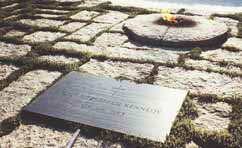
I started in the Washington office of John Carl Warnecke in May of 1962. The office worked on a number of projects for the Kennedy administration, along with private commissions for Mrs. Kennedy and Robert Kennedy, the President’s brother. Warnecke was also among the team working with the President to select a site for the Presidential Library. So, by fall of 1963, in my capacity as Warnecke’s office director, I had been in multiple meetings with the President and Mrs. Kennedy. Little that led up to that terrible day in November, though, or anything in my training as an architect, prepared me for the next twelve months.
On November 23, 1964, one day after the assassination, Defense Secretary Robert McNamara called the office looking for Warnecke, who was in Hawaii working on a new state capital. Warnecke caught an overnight flight to Washington to attend the funeral and help a small team, which included Mrs. Kennedy and Bobby, then the U.S. Attorney General, to select a suitable gravesite at Arlington Cemetery. Once a site was chosen, we launched an intensive research effort into gravesite and memorial design. We studied the graves of famous people, military leaders, politicians, especially those who had been assassinated. We studied the history and protocols of Arlington Cemetery and of our great national memorials. By January, we submitted our findings, which consisted of a mountain of research and some preliminary design criteria.
After two extremely emotional meetings with Mrs. Kennedy and Bobby, we set out on the design. We knew that the site called for a landscape solution, so we called in Lawrence Halprin, Hideo Sasaki, and Thomas D. Church for advice. This was the beginning of more than sixty meetings and work-sessions with well over a hundred architects, sculptors, advisors, cabinet members, and virtually every member of the Kennedy family. In our minds, each voice was to be heard, and each opinion mattered. By spring of 1964, we developed what we felt was a suitable design.
While the design was progressing, however, a debate had been going on within the family over symbolism. The Kennedys were an intensely religious family, and John was the nation’s first Catholic president. Some felt that the grave should have a more literal representation of the President’s faith, perhaps a cross, while others thought it should be more secular. Mrs. Kennedy instructed us to bring in as many advisors as we needed to resolve the issue, so that spring and early summer were spent consulting with liturgical experts, religious sculptors, theologians, and every Kennedy who had an opinion. The issue seemed unsolvable until Eunice Shriver suggested a meeting with Rev. Martin D’Arcy, S.J., a Jesuit and old Kennedy friend. (Later I learned that Father D’Arcy was one of the world’s most respected Christian philosophers.)
Father D’Arcy reviewed the design, the stacks of reports and meeting notes, and he seemed quite pleased with the outcome. With regard to symbolic elements, he advised that religion need not be advertised; it is something between an individual and his God. He felt that the grave must be fitting, noble, and intimate; it was not essential to have a cross as a vertical element. If a cross were to be used, it would be preferable to have it as a part of the element that covers the body. He suggested that we have a marker with the name and the dates of life with a small cross above the name. We had a solution—a simple, elegant solution.
The rest of the summer was spent reviewing the design with the family, adjusting things slightly, and working through the technical issues of the eternal flame. Little about the design was without controversy, but Father D’Arcy was a powerful advocate. The team prepared for a November 16 press conference (though nobody called them press conferences back then) and an unveiling of the design at the National Gallery of Art—almost one full year after the assassination.
The afternoon before the unveiling, we received a call from Bobby, who had been talking with family members who were concerned that the symbolism issue had not been satisfactorily addressed. We had come so far and everyone knew we were so close—but it looked as if everything would come to a screeching halt. Undaunted, we put our heads together and wrote a one-page statement on the “Religious Significance of the Design.” The family loved it, and we held the press conference the next morning.
After receiving his B. Arch. from Texas A&M University in 1962, author Harold L. Adams, FAIA, RIBA, JIA, worked in Washington, D.C., for John Carl Warnecke & Associates, for whom he served as project manager for President John F. Kennedy’s gravesite in Arlington National Cemetery. He joined RTKL in 1967, becoming its President in 1969, CEO in 1971, and Chairman in 1987. He retired in 2004 and is Chairman Emeritus of RTKL Associates, Inc. and RTKL International, Ltd.
Editor’s note: Architect John Carl Warnecke died in early 2010. The author told this story at the memorial celebration at Warnecke’s ranch near Healdsburg.
Originally published 4th quarter 2010, in arcCA 10.4, “Faith & Loss.”





